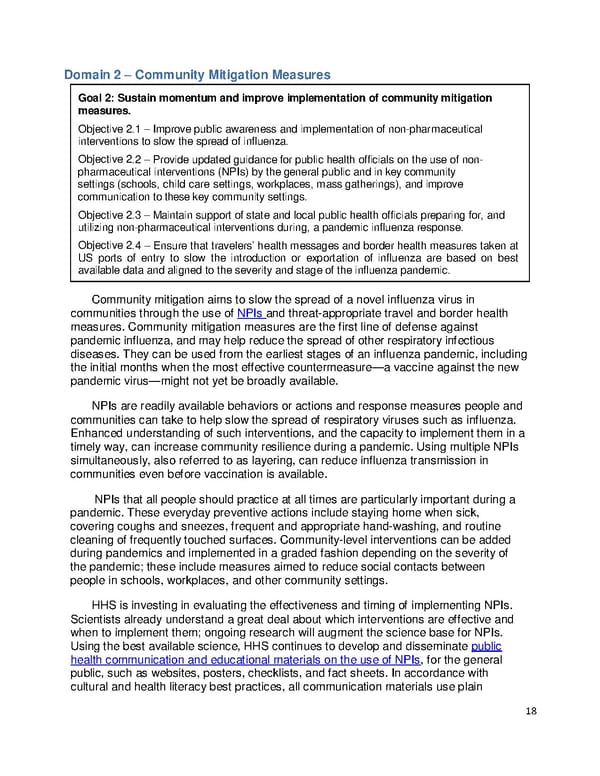Domain 2 – Community Mitigation Measures Goal 2: Sustain momentum and improve implementation of community mitigation measures. .1 – Improve public awareness and implementation of non-pharmaceutical Objective 2 interventions to slow the spread of influenza. Objective 2 .2 – Provide updated guidance for public health officials on the use of non- pharmaceutical interventions (NPIs) by the general public and in key community settings (schools, child care settings, workplaces, mass gatherings), and improve communication to these key community settings. .3 – Maintain support of state and local public health officials preparing for, and Objective 2 utilizing non-pharmaceutical interventions during, a pandemic influenza response. Objective 2 .4 – Ensure that travelers’ health messages and border health measures taken at US ports of entry to slow the introduction or exportation of influenza are based on best available data and aligned to the severity and stage of the influenza pandemic. Community mitigation aims to slow the spread of a novel influenza virus in communities through the use of NPIs and threat-appropriate travel and border health measures. Community mitigation measures are the first line of defense against pandemic influenza, and may help reduce the spread of other respiratory infectious diseases. They can be used from the earliest stages of an influenza pandemic, including the initial months when the most effective countermeasure—a vaccine against the new pandemic virus—might not yet be broadly available. NPIs are readily available behaviors or actions and response measures people and communities can take to help slow the spread of respiratory viruses such as influenza. Enhanced understanding of such interventions, and the capacity to implement them in a timely way, can increase community resilience during a pandemic. Using multiple NPIs simultaneously, also referred to as layering, can reduce influenza transmission in communities even before vaccination is available. NPIs that all people should practice at all times are particularly important during a pandemic. These everyday preventive actions include staying home when sick, covering coughs and sneezes, frequent and appropriate hand-washing, and routine cleaning of frequently touched surfaces. Community-level interventions can be added during pandemics and implemented in a graded fashion depending on the severity of the pandemic; these include measures aimed to reduce social contacts between people in schools, workplaces, and other community settings. HHS is investing in evaluating the effectiveness and timing of implementing NPIs. Scientists already understand a great deal about which interventions are effective and when to implement them; ongoing research will augment the science base for NPIs. Using the best available science, HHS continues to develop and disseminate public health communication and educational materials on the use of NPIs, for the general public, such as websites, posters, checklists, and fact sheets. In accordance with cultural and health literacy best practices, all communication materials use plain 18
 Pandemic Influenza Plan Page 17 Page 19
Pandemic Influenza Plan Page 17 Page 19